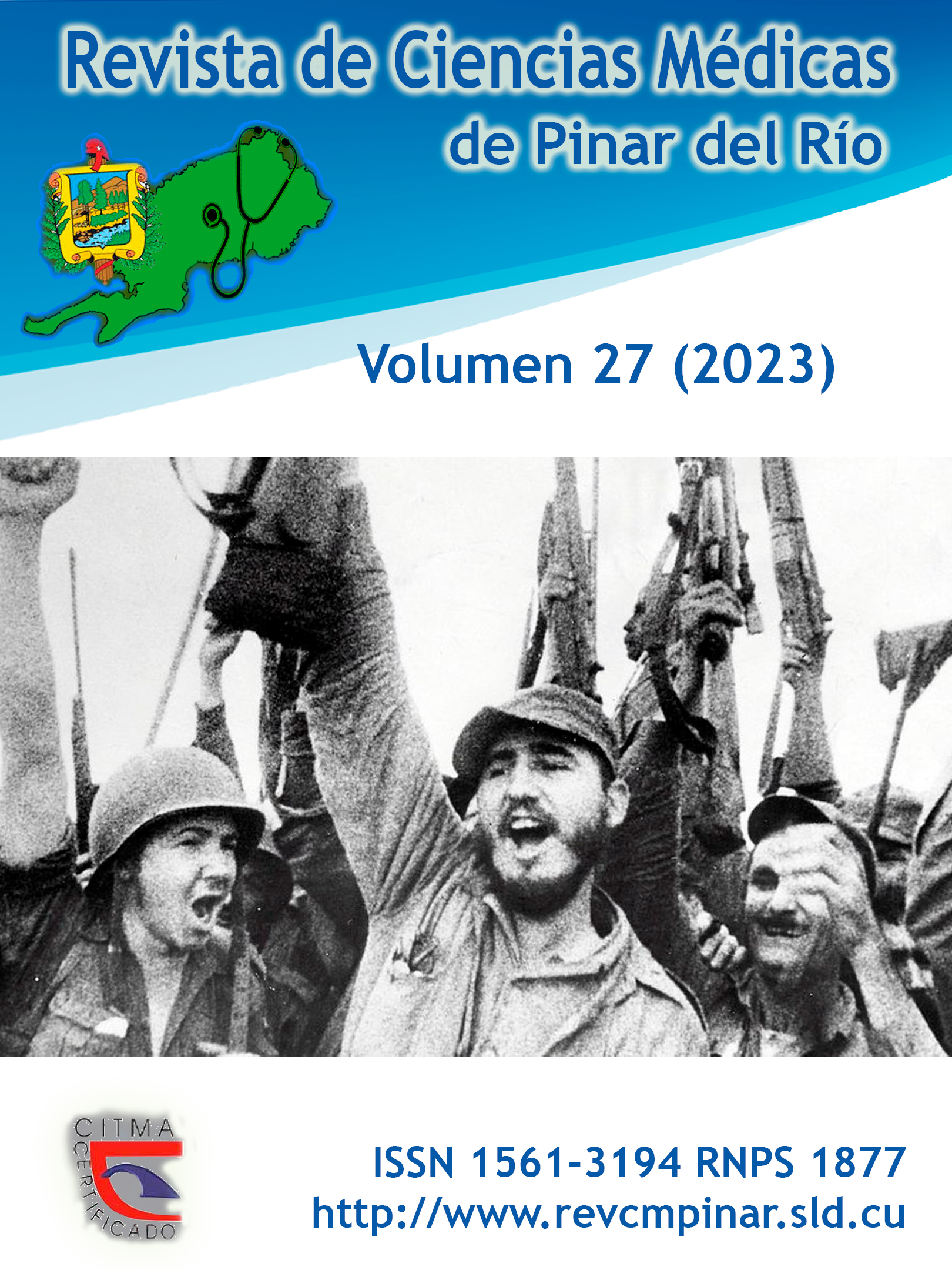Critical analysis of the Pediatric Dentistry program in the 4th year of the Stomatology Career
Keywords:
PEDIATRIC DENTISTRY, CURRICULUM, PROGRAM EVALUATION, PROFESSIONAL TRAINING.Abstract
Introduction: the training of the stomatologist requires the management of the quality of the curriculum concretized in a coherent and systematic methodological work.
Objective: to analyze from a critical approach the program of the subject Pediatric Dentistry for the 4th year of the Stomatology course.
Methods: a qualitative descriptive transversal study was carried out during the first semester of the 2022 course. Theoretical and empirical methods were used, such as documentary review, review of the Pediatric Dentistry course syllabus and its P1 by expert teachers, considering the components of the educational teaching process given by the problem, objectives, contents, methods, means, organizational forms of teaching and evaluation.
Results: it was determined that the 136 hours dedicated to education at work are sufficient for the acquisition of elementary skills in child care. Weaknesses were found in the program related to the organizational forms, teaching methods and means, and the evaluation system. It was identified that no subject presents seminars as a key instrument for the preparation and evaluation of the student.
Conclusions: in the program analyzed, the contents are well designed, as well as the curricular strategies proposed to implement in each subject. It requires modifications in the organizational forms of teaching, which will have a positive impact on the productive methods and the evaluation system. It also requires a relevant basic literature, updated and coherent in its contents with the rest of the literature to be used.
Downloads
References
1.Martínez Guerra A, Castellanos Martínez B. Papel de la Universidad en el desarrollo de la investigación estudiantil en el proceso de formación. Medisur [Internet]. 2018 [citado 14/10/2022]; 16(3): 492-5. Disponible en: https://www.medigraphic.com/pdfs/medisur/msu-2018/msu183r.pdf
2.Hernández Infante RC, Infante Miranda ME. La clase en la educación superior, forma organizativa esencial en el proceso de enseñanza-aprendizaje. Educación y Educadores [Internet]. 2017 [citado 14/10/2022]; 20(1): 27-40. Disponible en: https://biblat.unam.mx/hevila/Educacionyeducadores/2017/vol20/no1/2.pdf
3.Hernández Suárez D, Rodríguez Acosta Y, Hernández Suárez D, Tápanes Acosta M. Las estrategias curriculares en función de la formación integral del egresado de las ciencias médicas. EDUMECENTRO [Internet]. 2022 [citado 14/10/2022]; 14(s/n): e1729. Disponible en: http://revedumecentro.sld.cu/index.php/edumc/article/view/1729
4.Espinosa Vázquez O, Sánchez Mendiola M, Leenen I. Evaluación del desarrollo de la competencia clínica en odontopediatría con el examen clínico objetivo estructurado. Inv Ed Med [Internet]. 2020 [citado 14/10/2022]; 9(34): 53-62. Disponible en: https://www.medigraphic.com/pdfs/invedumed/iem-2020/iem2034g.pdf
5.Fernández García A. Análisis del programa de farmacología para la carrera de Estomatología. MediSur [Internet]. 2021 [citado 14/10/2022]; 19(1): 133-41. Disponible en: https://www.medigraphic.com/pdfs/medisur/msu-2021/msu211o.pdf
6.Creagh Bandera R, Creagh Bandera F, Cazull Imbert I, Creagh Cazull A. El pase de visita desde la perspectiva médico-pedagógica. RevInfCient [Internet]. 2020 [citado 14/10/2022]; 99(6): 563-571. Disponible en: http://scielo.sld.cu/pdf/ric/v99n6/1028-9933-ric-99-06-563.pdf
7.Vinent González R, Gómez Cruz M. Análisis del programa de la asignatura Operatoria Clínica. Revista de Ciencias Médicas de Pinar del Río [Internet]. 2017 [citado 14/10/2022]; 21(6): 927-35. Disponible en: http://scielo.sld.cu/pdf/rpr/v21n6/rpr19617.pdf
8.Rojas Alcina MC, Moreno Toirán G, Valle Santos GR. El trabajo metodológico en la disciplina principal integradora formación laboral investigativa. Una herramienta útil para su dirección. Luz [Internet]. 2019 [citado 14/10/2022]; 18(1): 103-13. Disponible en: https://www.redalyc.org/journal/5891/589164355010/589164355010.pdf
9.Sánchez Fernández N, Sánchez Clemente A, Thomas Ferrer F, Tabera García M. Programa de la disciplina Estomatología Integral. Análisis del plan de estudio “D”. Rev. Inf. Cient [Internet]. 2017 [citado 14/10/2022]; 96(2): 280-287. Disponible en: http://revinfcientifica.sld.cu/index.php/ric/article/view/7
10.Chaple Gil AM, Gispert Abreu EA, Alea González M, Fernández E. La mínima intervención en cariología en el plan de estudios D de la carrera de Estomatología en Cuba. Rev Cubana Estomatol [Internet]. 2021 [citado 14/10/2022]; 58(1): e3712. Disponible en: http://scielo.sld.cu/pdf/est/v58n1/1561-297X-est-58-01-e3712.pdf
11.Enríquez Clavero JO, González Hernández G. La superación profesional pedagógica de los docentes en la educación médica superior cubana. Atlante Cuadernos de Educación y Desarrollo [Internet]. 2019 [citado 14/10/2022];(s/n). Disponible en: https://www.eumed.net/rev/atlante/2019/04/superacion-profesional-pedagogica.html
12.García Hernández M, Lugones Botell M, Lozada García L. Algunas formas de organización y presentación del contenido científico en los eventos. Acta Cient Estud [Internet]. 2018 [citado 14/10/2022]; 6(2): 66-70. Disponible en: https://www.medigraphic.com/pdfs/estudiantil/ace-2018/ace082f.pdf
13.Rodríguez Pérez M, González López ME. Metodología para la realización de un seminario participativo en la asignatura Microbiología y Parasitología Médicas. Educ Med Super [Internet]. 2017 [citado 14/10/2022]; 31(2): 1-7. Disponible en: http://scielo.sld.cu/pdf/ems/v31n2/ems16217.pdf
14.Herrera Moya V, Alfonso Tejeda I, Quintana Uguando M, Pérez Inéranty M, Navarro Aguirre L, Sosa Fleites I. Formación vocacional y motivación: su incidencia en el estudio de la carrera de Medicina. EDUMECENTRO [Internet]. 2018 [citado 14/10/2022]; 10(2): 111-125. Disponible en: http://scielo.sld.cu/pdf/edu/v10n2/edu09218.pdf
15.Comisión Nacional de Carrera. Plan de Estudio “D” Carrera de Medicina. La Habana: Universidad de Ciencias Médicas de la Habana; 2015.
16.Comisión Nacional de Carrera. Plan de Estudio “E” Carrera de Medicina. La Habana: Universidad de Ciencias Médicas de la Habana; 2019.
Downloads
Published
How to Cite
Issue
Section
License
Authors who have publications with this journal agree to the following terms: Authors will retain their copyrights and grant the journal the right of first publication of their work, which will be publication of their work, which will be simultaneously subject to the Creative Commons Attribution License (CC-BY-NC 4.0) that allows third parties to share the work as long as its author and first publication in this journal are indicated.
Authors may adopt other non-exclusive license agreements for distribution of the published version of the work (e.g.: deposit it in an institutional telematic archive or publish it in a volume). Likewise, and according to the recommendations of the Medical Sciences Editorial (ECIMED), authors must declare in each article their contribution according to the CRediT taxonomy (contributor roles). This taxonomy includes 14 roles, which can be used to represent the tasks typically performed by contributors in scientific academic production. It should be consulted in monograph) whenever initial publication in this journal is indicated. Authors are allowed and encouraged to disseminate their work through the Internet (e.g., in institutional telematic archives or on their web page) before and during the submission process, which may produce interesting exchanges and increase citations of the published work. (See The effect of open access). https://casrai.org/credit/



